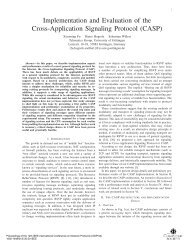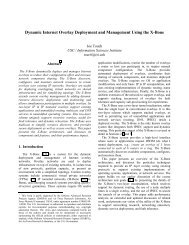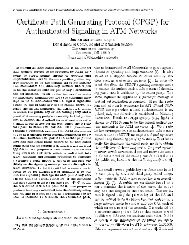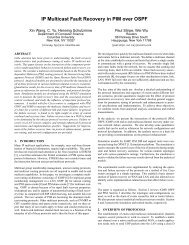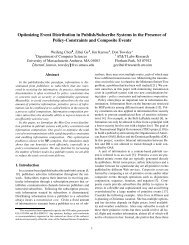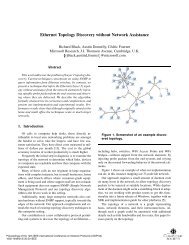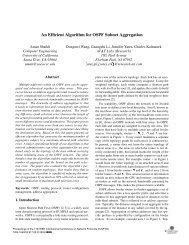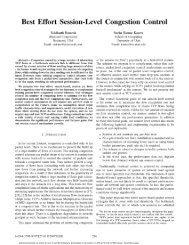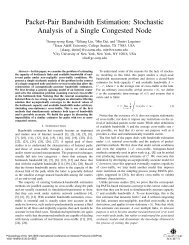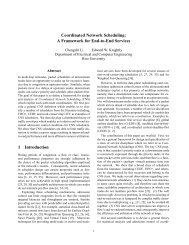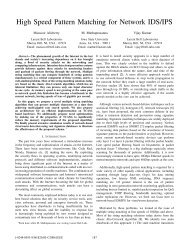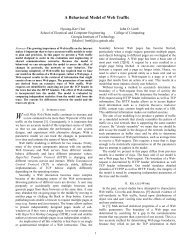Shape Shifting Tries for Faster IP Route Lookup - ICNP
Shape Shifting Tries for Faster IP Route Lookup - ICNP
Shape Shifting Tries for Faster IP Route Lookup - ICNP
You also want an ePaper? Increase the reach of your titles
YUMPU automatically turns print PDFs into web optimized ePapers that Google loves.
2 and 3 discuss the SST coding scheme and the <strong>IP</strong> lookupalgorithm, respectively. Section 4 describes the SST constructionalgorithm. Section 5, introduces two additionaloptimizations that remove redundancies from the underlyingbinary trie, providing additional per<strong>for</strong>mance improvement.An improved hybrid algorithm is introduced in Section6 and the reference implementation is discussed in Section7. The algorithm per<strong>for</strong>mance is evaluated <strong>for</strong> both<strong>IP</strong>v4 and <strong>IP</strong>v6 tables in Section 8. Incremental update ofSST is discussed in Section 9. Section 10 summarizes therelated work and we conclude the paper in Section 11.2 SST RepresentationThe nodes of an SST correspond to subtrees of the underlyingbinary trie, with up to K nodes, where K is a parameterof the data structure. Since these subtrees can havean arbitrary shape, each SST node includes a shape bitmap(SBM) that represents the subtree’s shape. The encodingwe use was described by Jacobson [9]. To encode a tree, wefirst augment the tree with additional dummy nodes. Eachoriginal node with no children, gets two dummy children.Each original node with one child gets one dummy child.We then associate a bit with each node in the augmentedtree. The value of this bit is ‘1’ <strong>for</strong> each of the originalnodes and ‘0’ <strong>for</strong> each of the dummy nodes. The shapebitmap consists of this set of bits, listed in breadth-first order.We omit the bit corresponding to the root, since thisbit is always ‘1’. The shape bitmap <strong>for</strong> a tree with K originalnodes has 2K bits and any tree with up to K nodescan be represented by a shape bitmap with 2K bits. We canalso view the shape bitmap as associating two bits with eachoriginal node. These bits indicate which of the node’s potentialchildren are present in the tree. In our illustrations,we typically adopt this viewpoint, to avoid showing dummynodes explicitly.In addition to the shape bitmap, an SST node includes aninternal bitmap (IBM) with K bits. This identifies whichof the binary trie nodes has an associated prefix. An SSTnode also includes an external bitmap (EBM) with K +1bits that identifies which of the potential “exit points” fromthe subtree corresponds to an actual node in the underlyingbinary trie. The bits of the internal and external bitmaps arelisted in breadth-first order of the corresponding nodes.Each SST node also includes two pointers. The childpointer points to the first SST node that is a child of thegiven SST node. The next hop pointer points to the next hopin<strong>for</strong>mation <strong>for</strong> the first binary trie node in the SST node<strong>for</strong> which there is a prefix. The children of a given SSTnode are stored in sequential memory locations (allowingus to access any of the children using the pointer to the firstone). Similarly, the next hop in<strong>for</strong>mation <strong>for</strong> all the nodesis stored in sequential locations, allowing us to access thenext hop in<strong>for</strong>mation <strong>for</strong> any binary node, given a pointer tothe next hop in<strong>for</strong>mation <strong>for</strong> the first binary node <strong>for</strong> whichthere is a prefix.Figure 1 shows a binary trie that has been divided intosubtrees of size less than or equal to three, along with thecorresponding shape-shifting trie.0 10 10011a c eSBM: 01 01 00IBM: 1 0 1EBM: 1 0 1 1Child NextHop NextHop(a)NextHop(e)b d f g h iSBM: 10 00IBM: 0 1EBM: 0 0 0Null NextHopNextHop(d)SBM: 00IBM: 1EBM: 0 0Null NextHopNextHop(f)SBM: 11 00 00IBM: 0 1 1EBM: 0 0 0 0Null NextHopNextHop(h)NextHop(i)Figure 1. An SST with K=3 and the corresponding datastructure. The darker binary trie nodes represent valid prefixes.3 <strong>Lookup</strong> in an SSTThe lookup process in an SST is similar to the lookupprocess <strong>for</strong> the tree bitmap algorithm [2]. The search proceedsrecursively, starting from the root. At each step, weuse bits from the address prefix to move through the subtreeof the binary trie represented by the current SST node. Weuse the shape bitmap and external bitmap to allow us to determineif the search terminates at this node or continues toone of its children. If it does continue to a child, we findthe bit in the external bitmap that corresponds to the childand count the number of ‘1’s in the bitmap that precede thisbit. We then use this number as an offset to the child nodeof interest, from the array of children starting at the locationspecified by the child pointer. An example illustrating thisprocess is shown in Figure 2.The basic step in the search algorithm requires decodingthe shape bitmap. The key step is to find the bits in the shapebitmap that correspond to nodes in the path traversed by asearch using bits from the <strong>IP</strong> address prefix. We start bydefining n i to be the number of nodes at distance i from theroot of the augmented version of the subtree represented bythe SST node (including dummy nodes). We let f i denotethe position of the bit in the shape bitmap that correspondsto the first node at distance i from the root. Note that n 1 =2, f 1 = 0 (since we omit from the shape bitmap the bitcorresponding to the root) and f i = f i−1 + n i−1 .Wedefineones(i, j) to be the number of ones in the shape bitmap inthe range of bits from i through j, and note that n i =2×ones(f i−1 ,f i − 1).
0 10 10011a c eSBM: 01 01 00IBM: 1 0 1EBM: 1 0 1 1Child NextHop+1b d fg h iSBM: 00IBM: 1SBM: 10 00IBM: 0 1EBM: 0 0 0Null NextHopNextHop(d)+1NextHop Pointer Offset = 1Child Pointer Offset = 1NextHop(a)NextHop(e)EBM: 0 0Null NextHopNextHop(f)SBM: 11 00 00IBM: 0 1 1EBM: 0 0 0 0Null NextHopNextHop(h)NextHop(i)Figure 2. Assuming the <strong>IP</strong> address under lookup is“1100”. The first SST node lookup returns the child pointerand the best matched prefix so far; the second SST nodelookup returns the best matched prefix.Next, we let a i be the i-th bit of the <strong>IP</strong> address thatis relevant to the node currently being decoded (so a 1 selectsa child of the root of the subtree represented by thecurrent node). We also let p i be the index in the shapebitmap corresponding to the node on the path specified bythe <strong>IP</strong> address that is at distance i from the root of thesubtree. With these definitions, p 1 = a 1 and <strong>for</strong> i>1,p i = f i +2× ones(f i−1 ,p i−1 − 1) + a i .Now, if i is the smallest integer <strong>for</strong> which the shapebitmap at position p i is zero, then p i corresponds to thepoint where the search on the <strong>IP</strong> address leaves the subtreerepresented by the current SST node. To determineif the search continues to another SST node, we need toconsult the external bitmap. The position in the externalbitmap that must be checked is the one with index equal tozeros(0,p i − 1) where zeros(i, j) is defined to be the numberof zeros in the shape bitmap in the range of bits from ithrough j. If x is the index of the proper bit in the externalbitmap, and if bit x of the external bitmap is equal to‘1’, then the search continues at a child of the current SSTnode. To find the next SST node, we add an offset to thechild pointer. This offset is equal to the number of ones inthe external bitmap preceding bit x.Consider the example shown in Figure 2. In the rootSST node, we find n 1 = n 2 = n 3 =2, f 1 =0, f 2 =2,f 3 =4, p 1 =1, p 2 =3, p 3 =4.Sincebitp 3 of the shapebitmap is the first of the p i bits that equals zero, we countthe number of zeros in the shape bitmap preceding position4. Since there are two zeros, we consult position 2 in theexternal map to determine if the search continue to anotherSST node. Since bit 2 of the external bitmap is 1, there is anextending path. Also, since there is a single 1 in the externalbitmap be<strong>for</strong>e bit 2, we add 1 on to the child pointer to findthe next SST node.There are several ways to implement the lookup process<strong>for</strong> a single SST node. One conceptually simple approachis to use the equations derived above to define a combinationalcircuit that computes the values of p i <strong>for</strong> 1 ≤ i ≤ K.This is fast, but does require a relatively large amount ofcircuitry. A simpler alternative is to use a sequential circuitthat <strong>for</strong> i ≥ 1, computes values of n i , f i and p i iterativelyon successive clock ticks, terminating as soon as the shapebitmap at position p i is equal to zero. This takes up to Kclock ticks, plus another clock or two to decode the externalbitmap and add the offset to the child pointer <strong>for</strong> the nextmemory access.While the time needed to decode an SST node sequentiallycan be fairly long, note that the overall time to per<strong>for</strong>ma lookup is essentially one clock tick per address bit,plus one memory access time per SST node searched. Sincethe lookup process does not change the SST, we can havemultiple lookup engines operating in parallel on differentpackets, with their memory accesses interleaved. Thus, thetime to do a lookup at a single node only affects the numberof engines required, not the throughput. The throughput isa function only of the memory bandwidth and the numberof memory accesses needed per lookup. See [10] <strong>for</strong> a descriptionof how this technique is used with the tree bitmapalgorithm of [2].4 Constructing Optimal SSTsA given binary trie can be represented by many differentSSTs, depending on how the binary trie is partitioned. Sinceour primary concern is minimizing the search time, we focuson SSTs that have minimum height, where the height ofa tree is defined as the length of a longest path from the rootofthetreetoaleaf.However, we start by considering how to find an SSTwith a minimum number of nodes, ignoring the question ofheight. This can be done using a post-order traversal of thebinary trie, pruning off subtrees to <strong>for</strong>m SST nodes. Lets(x) be the number of nodes in the subtree of the currentpruned binary trie with root x. When we visit node x in apost-order traversal, we per<strong>for</strong>m the following step.1. if s(x) =K, prune the subtree at x and assign all ofits nodes to a new SST node.2. otherwise, if s(x) > K and x has children a and bwith s(a) ≥ s(b), prune the subtree at a and assign itsnodes to a new SST node.We call this the Post-Order Pruning (POP) algorithm. Figure3(a) shows an example of the partitioning produced bythe POP algorithm <strong>for</strong> K = 3. Figure 3(b) also showsa minimum height partitioning. Notice that the minimumheight partition has a height of one and yields five SSTnodes, while the minimum size partition has a height ofthree and yields four SST nodes. The example makes itclear that a single SST cannot be optimal with respect toboth criteria.
Theorem 1 The SST constructed by the POP algorithm <strong>for</strong>a given binary trie has the minimum number of nodes.We sketch the proof of the optimality of the POP algorithm.We claim that the algorithm maintains the followinginvariant.• Invariant: after every step, there is some SST witha minimal number of nodes that includes all the SSTnodes <strong>for</strong>med so far.This is clearly true when the algorithm starts and if it is truewhen the algorithm completes, then the constructed SSTmust be optimal. So, it suffices to show that the pruningrules maintain the invariant. Consider an application of thefirst pruning rule and let T be a minimum size SST that includesthe nodes <strong>for</strong>med so far. If T does not <strong>for</strong>m a nodefrom the entire subtree at x, then at least one descendantof x must be in a different SST node than x is. This SSTnode cannot contain any nodes that are not descendants ofx. Consequently, we can modify T so that it does <strong>for</strong>m asingle node from the subtree at x. The partition that T imposeson the rest of the binary trie remains unchanged. ThisSST cannot have any more nodes than T has.Now, consider the second pruning rule. Again, let T bea minimum size SST that includes the nodes <strong>for</strong>med so far.Note that due to the post-order traversal, K>s(a) ≥ s(b).Because s(x) >K, T cannot <strong>for</strong>m a single node from thesubtree at x. Any subtree that is pruned from the subtree atx leaves behind at least 1+s(b) nodes. Consequently, wecan modify T so that it includes a node <strong>for</strong> the subtree ata, but is otherwise unchanged. This modified SST cannothave any more nodes than T . So far the optimality of thePOP algorithm is proved.We now turn our attention to constructing minimumheight SSTs. This requires a somewhat more complicatedmethod that we call the Breadth-First Pruning (BFP) algorithm.BFP operates in multiple steps, successively pruningoff subtrees with at most K nodes. It starts by computings(x), the number of descendants of node x in the binarytrie, <strong>for</strong> each binary trie node x. It then repeats the followingstep until there is nothing left of the binary trie.• Scan the current pruned binary trie in breadth-first order.Whenever a binary trie node y with s(y) ≤ K isfound, prune y and its descendants from the trie andassign them to a new SST node. For all ancestors x ofy, subtract s(y) from s(x).BFP can be implemented to run in O(n 2 ) time, wheren is the number of nodes in the underlying binary trie. Wenow show that it does produce minimum height SSTs.Consider any minimum height SST <strong>for</strong> a given binarytrie. We say that a binary trie node u “belongs” to an SSTnode x, ifu is in the subtree corresponding to x. We assign(a)Figure 3. Minimum size and minimum height partitionsof a binary tree.each binary trie node u a label h(u) equal to the height ofthe SST node it belongs to. To establish the optimality of theBFP algorithm we first prove a few properties concerningthese labels.Lemma 1 For any node u, the number of descendants v ofu (including u itself) with h(v) =h(u) is at most K.Proof: Let S be the set of descendants v of u withh(v) =h(u). Assume that S contains more than K nodesand note that, they cannot all belong to the same SST node.If U is the SST node that u belongs to, there must be somenode v in S that belongs to a child V of U. But the height ofU cannot equal the height of V , contradicting the assumptionthat S contains more than K nodes. ✷We call each of the steps per<strong>for</strong>med by the BFP algorithma pass.Lemma 2 After i passes of the BFP algorithm, the binarytrie contains no nodes u with h(u) ≤ i − 1.Proof: Proof by induction. The basis i =0is triviallysatisfied, since h(u) ≥ 0 <strong>for</strong> all u.For the inductive step, assume that at the beginning ofpass i, the trie contains no nodes u with h(u) ≤ i − 2.Suppose that at end of pass i, there is some node u withh(u) =i − 1. Since u was not removed from the trie, itmust have already been considered in the breadth-first scanper<strong>for</strong>med by BFP. Since it was not removed from the trie,it must have had more than K descendants at the time it wasconsidered. But since all of its descendants v have h(v) =i − 1, this contradicts Lemma 1. ✷Lemma 3 Let x and y are two SST nodes <strong>for</strong>med by theBFP algorithm in the same pass, then neither is an ancestorof the other.Proof: The BFP algorithm scans the underlying binarytrie in breadth-first order. In one pass, if a node is pruned,all of its ancestors have already been scanned and will notbe touched again in the same pass. ✷(b)
With these lemmas, we are now prepared to show thatBFP produces minimum height SSTs.Theorem 2 The SST constructed by the BFP algorithm <strong>for</strong>a given binary trie has the minimum height. The height isone less than the number of passes per<strong>for</strong>med by BFP.Proof: Let r be the root of the binary trie and let T bethe SST constructed by BFP. By Lemma 2, the SST nodecontaining r is <strong>for</strong>med by the end of pass h(r) +1. ByLemma 3, no path from the root of T to one of its descendantspasses through more than one node <strong>for</strong>med in thesame pass. Hence, the height of T is at most h(r). Sinceh(r) was defined relative to a minimum height SST, it followsthat T has minimum height also. ✷5 Optimizations on Underlying Binary TrieSince the size of the underlying binary trie directly correlateswith the size of the SST, a smaller underlying trie ispreferred, in order to reduce the memory usage. The realroute lookup tables contain certain redundancies that can beexploited to compress the underlying binary trie. We brieflysummarize two simple techniques called child promotionand nearest ancestor collapse that can be used to removesuch redundancies. We need to note that these optimizationshave little effect on the multibit trie algorithm.Figure 4 illustrates the child promotion optimization. Iftwo child nodes of a binary trie node both represent validprefixes, we can use a one-bit shorter prefix to replace oneof these two longer prefixes without changing the LPMlookup results. If this promoted child node is a leaf node,we can safely delete this child node after the promotion.Our second optimization is based on the observation that<strong>for</strong> route lookups, it does not matter which prefixes arematched, but rather what next hop is selected. The distinctnext hops is typically much fewer than the prefixes, makingit possible to eliminate certain prefixes. In general, if thenext hop of a node in the binary trie is the same as the nexthop of its nearest ancestor that corresponds to a prefix, wecan eliminate the first prefix. Figure 5 illustrates the nearestancestor collapse optimization.121Figure 5. Nearest Ancestor Collapse: the darker nodesrepresent the valid prefixes and the number in the nodes indicatesthe next hop.The binary trie is traversed in the post order to per<strong>for</strong>mthis optimization. For each valid prefix, we examine itsnearest ancestor which is also a valid prefix and comparetheir next hops. If they are same, we delete the next hopin<strong>for</strong>mation in the longer prefix and invalidate this prefix. Ifthis node is also a leaf node, we recursively delete the nodesupwards until we meet its nearest ancestor or a tree branch.This optimization decreases the number of binary trienodes as well as the number of valid prefixes. Liu usessimilar technique to compress the route lookup tables andshows that the number of valid prefixes can be reduced byup to 26.6% [14].210 10 10C6 A Hybrid AlgorithmA0 1BCAFigure 4. Child Promotion: the darker nodes representthe valid prefixes. We promote the prefix A in the first stepand C in second step.To per<strong>for</strong>m this optimization, after building the binaryprefix trie, we traverse the trie in the post order. If the twochild nodes of a binary trie node are valid prefixes, we promoteone of them to be the parent node. If one of the childrenis a leaf, we select it <strong>for</strong> promotion and delete the leaf.We find this optimization works quite well. It deletes 5.23%(5,426) of tree nodes and promotes 7,179 prefixes from theMae-West route lookup table. For the much larger <strong>IP</strong>v4BGP table used in our earlier experiments, it deletes 10.78%(52,585) of the tree nodes and promotes 74,804 prefixes.B1CAB1The shape shifting trie method <strong>for</strong> longest prefix matchingis a generalization of the tree bitmap algorithm(TBM) [2]. In both algorithms, the data structure node includesan internal bitmap, an external bitmap, a single childpointer and a single next hop pointer. However, SST also requiresa shape bitmap that must be taken into account whencomparing the two.If we let K =2 S be the SST node size, then an SSTnode needs 4K +1bits <strong>for</strong> its three bitmaps. A TBM nodecan use these bits to implement a multibit trie node with astride of S +1, corresponding to a subtree of the binarytrie with 2K − 1 nodes. So, if the underlying binary trie isdense, the TBM data structure can be more space-efficientthan the SST, but if the binary trie is sparse (fewer than halfthe ”potential” nodes are actually present), the SST is morespace-efficient. Because such sparse subtrees are very commonin the tries that represent large routing tables, SST istypically more space-efficient than TBM.
The more important advantage of SST is its potential toreduce the trie height. In the extreme case of a trie that consistsof one long path with m modes, a TBM data structurehas a height of approximately m/(S +1)while a comparableSST has a height of m/2 S .ForS =4, this is morethan a three-to-one improvement. In practice we don’t expectsuch dramatic gains, but we do find improvements ashigh as two-to-one <strong>for</strong> <strong>IP</strong>v6 in Section 8.This discussion suggests that it may be worthwhile to usea hybrid approach in which TBM nodes are used to representdense parts of the trie, while SST nodes are used torepresent sparse parts. We use a bit in the node data structureto identify the <strong>for</strong>mat used <strong>for</strong> the current node. If thebit specifies a TBM node, we use 2K +1bits <strong>for</strong> the externalbitmap, and 2K bits <strong>for</strong> the internal bitmap. If the bitspecifies an SST node, we use 2K bits <strong>for</strong> the shape bitmap,K +1bits <strong>for</strong> the external bitmap and K bits <strong>for</strong> the internalbitmap. The hardware required to decode the two types ofnodes is simple enough that the cost of implementing bothtypes of lookup is not a significant issue.When building a hybrid trie, we must decide which nodetype to use. We modify the BFP algorithm to take this intoaccount. During each breadth-first scan, when we encountera node u, we first check to see if the height of the subtreewith root u is small enough to allow it to fit in a TBM-typenode. If it is, we prune the subtree and <strong>for</strong>m a TBM-typenode. Otherwise, we check to see if the number of nodes inthe subtree is small enough to fit in a single SST node. Ifso, we prune the subtree and <strong>for</strong>m an SST-type node. Notethat whenever we encounter a node in a breadth-first scan,we already know that the height of its parent is too large<strong>for</strong> a TBM node and the size of its parent’s subtree is toolarge <strong>for</strong> an SST node. Also, note that the height of thehybrid data structure cannot be any larger than the height ofan optimal SST. On the contrary, the hybrid data structurecan potentially reduce the trie height further.7 Reference ImplementationsThe per<strong>for</strong>mance evaluation to follow, is based on referenceimplementations of the TBM, SST and hybrid algorithms.We assume that in all three cases, the lookup datastructure is stored in a 200MHz QDRII SRAM with a 36bitwide data interface. These devices have a minimum burstsize of two words, which can be read and write in a singleclock cycle. In our reference implementations, the nodes<strong>for</strong> each data structure are stored in three words. For theTBM data structure (and <strong>for</strong> TBM nodes in the hybrid datastructure), this allows us to implement a stride of 5 (32 bits<strong>for</strong> the external bit map, 31 bits <strong>for</strong> the internal bitmap). ForSST nodes, there is enough space <strong>for</strong> K =16.All three algorithms use a variation of the prefix bit optimizationdescribed in references [2, 10]. This optimizationreduces the number of off-chip memory accesses substantially.It’s based on the observation that we don’t really needto look at the next hop pointer and the internal bitmap <strong>for</strong>most nodes visited during a search. We only need to examinethese fields <strong>for</strong> the node corresponding to the longestprefix. The prefix bit optimization allows us to identify thisnode, without looking at the next hop pointer and internalbitmap fields of all but two nodes visited. The optimizationis implemented using an extra bit in each data structurenode. This bit is set to a ‘1’ if the portion of the underlyingbinary trie corresponding to the parent node has a prefixthat is relevant to the child’s subtree. During the search,we remember the parent of the most recently visited nodewhose prefix bit was set. At the end of the search, we examinethe next hop pointer and internal bitmap of this parentnode. We also examine the next hop pointer and internalbitmap of the node where the search terminates. If all butthe next hop pointer and internal bitmap are placed in thefirst two words of the three words used to store a data structurenode, we only need to do one two-word access per datastructure node visited, plus one or two more to retrieve thebest matched next hop. Thus, if the data structure has aheight of H, the worst-case number of memory accesses isH +3.These considerations lead to the node <strong>for</strong>mats shown inFigure 6. In all cases, the third word contains the internalbitmap. For the SST node <strong>for</strong>mat it also contains the nexthop pointer. Because the parameter K <strong>for</strong> an SST nodedoes not have to be a power of two, one can increase theSST node size at the expense of reducing the number of bitsin the child pointer. The child pointer size is set to 20. Thisallows us to have up to a million SST nodes. We allocate 20bits to the next hop pointer, allowing <strong>for</strong> up to a million prefixes.Since the largest <strong>IP</strong>v4 prefix tables currently containfewer than 200,000 prefixes, this seems more than adequate.SST-nodeTBM-nodeNode Type Word 1 Word 2 Word 31 P SBM1 1 320 P1 1EBM32EBMChildPointer17 20ChildPointer20Next HopPointer20Next HopPointerIBM20 16Figure 6. Data Structure Node Formats: K=16 <strong>for</strong> SSTtypenode and S=5 <strong>for</strong> TBM-type node8 Per<strong>for</strong>mance EvaluationUsing our reference implementations, we per<strong>for</strong>medsimulations on real and synthetic <strong>IP</strong> route lookup tables toexamine the per<strong>for</strong>mance of our algorithms in terms of treeheight and tree size, which are determine the worst case13IBM31
lookup throughput and the memory consumption. Specifically,we compared three different algorithms: the treebitmap algorithm, the original BFP SST algorithm and theBFP hybrid algorithm. We also provide the statistics of theunderlying binary trie <strong>for</strong> reference. In the simulation wedid not optimize the underlying binary trie. The parametersettings are as shown in Figure 6.8.1 Per<strong>for</strong>mance on <strong>IP</strong>v4 <strong>Route</strong> <strong>Lookup</strong>To start, we simulated the algorithms <strong>for</strong> <strong>IP</strong>v4 lookup tables.We expect the largest per<strong>for</strong>mance improvement onsmall tables since we can expect the prefix tree to be sparseand contain a lot of long and skinny paths. However, weare particularly interested in the algorithm per<strong>for</strong>mance onvery large <strong>IP</strong> lookup tables. We used a recent snapshot ofthe AS1221 BGP table from [11] <strong>for</strong> analysis. This tablecontains about 184K prefixes and has the prefix length distributionshown in Figure 7.# of prefixes8.E+047.E+046.E+045.E+044.E+043.E+042.E+041.E+0 40.E+008 10 12 14 16 18 20 22 24 26 28 30 32Prefix LengthFigure 7. Prefix Length Distribution of <strong>IP</strong>v4 BGP TableThe prefixes lengths are distributed from 8 to 32. Almosthalf of the prefixes have length 24. Table 1 shows the testresults.Table 1. <strong>IP</strong>v4 BGP Table ResultsTrie #of Worst Case MemoryHeight Nodes Throughput (Bytes)Underlying Binary Trie 32 487,696 - -Tree Bitmap 6 64,245 22.2M pkts/s 845.0KBFP SST 5 49,177 25.0M pkts/s 648.3KBFP Hybrid 4 33,094 28.6M pkts/s 436.3KSST Optimal Bound 5 37,760 25.0M pkts/s 497.8KIn summary, the BFP Hybrid algorithm improves the trieheight by 33% and improves the trie size by 48% over thetree bitmap algorithm. The BFP SST algorithms reach theoptimal trie height while the multibit trie is 1 layer taller.On the other hand, both of the BFP SST and BFP hybridalgorithms decrease the total number of nodes significantlycompared with the tree bitmap algorithm. Surprisingly, theheight and size of the trie generated by the BFP Hybrid algorithmare even lower than the optimal bound <strong>for</strong> the pureBFP SST case. In all cases, the tables are small enough to fitin a single SRAM chip (4 MB chips are currently available).Assuming we fully utilize the memory bandwidth by deployingmultiple lookup engines and interleaving the memoryaccesses, the BFP hybrid algorithm needs only 7 memoryaccesses in the worst-case, per route lookup. Since theQDRII SRAM can per<strong>for</strong>m 200 million two-word accessesper second, it can sustain a throughput of 28.6 million packetsper second. Assuming a worst case packet size of 40bytes, the system can support 9.1 Gbps throughput, whichis close to the OC192 link rate.8.2 Per<strong>for</strong>mance on <strong>IP</strong>v6 <strong>Route</strong> <strong>Lookup</strong>Evaluation is somewhat more difficult <strong>for</strong> <strong>IP</strong>v6, as thereare no large real-world <strong>IP</strong>v6 routing tables available <strong>for</strong>analysis. We start with an available <strong>IP</strong>v6 BGP tablefrom [11]. This table has fewer than 900 prefixes, with theprefix length distribution shown in Figure 8.# of Prefixs400300200100016 32 48 64 80 96 112 128Prefix LengthFigure 8. Prefix Length Distribution <strong>for</strong> <strong>IP</strong>v6 BGP TableIn this table, prefixes with length 32, 48 and 64 dominateand only a handful of prefixes have length of 112, 126and 128 bits. Table 2 shows the test results. We note thatthe BFP SST and the BFP hybrid algorithms yield a trieheight less than one third that required by the tree bitmapalgorithm. This allows them to sustain a throughput that isalmost three times higher.Table 2. <strong>IP</strong>v6 BGP Table ResultsTrie #of Worst Case MemoryHeight Nodes Throughput (Bytes)Underlying Binary Trie 128 5,415 - -Tree Bitmap 25 1,013 7.14M pkts/s 13.4KBFP SST 8 530 18.2M pkts/s 7.0KBFP Hybrid 8 491 18.2M pkts/s 6.5KSST Optimal Bound 8 413 18.2M pkts/s 5.4KOne can argue that this comparison is unrealistic, sincecurrent <strong>IP</strong>v6 address allocation schemes [12] use the lower
half of the 128-bit <strong>IP</strong>v6 address <strong>for</strong> an interface ID. Thismakes it unnecessary to store more than the first 64 bits ofthe <strong>IP</strong> address prefix in the trie. To correct <strong>for</strong> this, we do asecond comparison in which all prefixes with length longerthan 64 have been removed. Table 3 summarizes the results.In this case, the BFP SST and BFP hybrid algorithmsstill provide more than a 2:1 reduction in the trie height andnearly a 2:1 reduction in the trie size, when compared to thetree bitmap algorithm.Table 3. Trimmed<strong>IP</strong>v6BGPTableResultsTrie #of Worst Case MemoryHeight Nodes Throughput (Bytes)Underlying Binary Trie 64 5,015 - -Tree Bitmap 12 934 13.3M pkts/s 12.3KBFP SST 5 498 25.0M pkts/s 6.6KBFP Hybrid 5 455 25.0M pkts/s 6.0KSST Optimal Bound 5 386 25.0M pkts/s 5.1KTo more fully evaluate our algorithms <strong>for</strong> the <strong>IP</strong>v6 case,we resort to synthetic <strong>IP</strong>v6 prefix sets, since there are nolarge real-world <strong>IP</strong>v6 tables available yet. We adopt themethodology developed in [13]. The authors observe thatwhile it is difficult to predict the structure of future largescale <strong>IP</strong>v6 route lookup tables, it’s possible to use the <strong>IP</strong>v6address allocation schemes and the characteristics of current<strong>IP</strong>v4 tables to infer in<strong>for</strong>mation that can be used to generaterealistic <strong>IP</strong>v6 tables. For evaluation, we generate an <strong>IP</strong>v6table with about 200K prefixes using the method proposedin [13]. The prefix length distribution of this table is shownin Figure 9.# of Prefixes6.E+045.E+044.E+043.E+042.E+041.E+040.E+00500400300200100016 18 20 22 24 26 28 301 8 15 22 29 36 43 50 57 64Prefix LengthFigure 9. Prefix Length Distribution <strong>for</strong> Synthetic <strong>IP</strong>v6TableAll the prefixes in this table are <strong>for</strong> global unicast addresses,which start with the first three bits of “001”. Theprefix length also retains some statistical characteristics ofthe <strong>IP</strong>v4 BGP table used in our earlier experiments, butscaled to <strong>IP</strong>v6. For example, the ratio of the number ofeven length prefixes to the number of odd length prefixes is3:1. A large portion of the prefixes have length of 32, 48and 64. This characteristic is also consistent with the <strong>IP</strong>v6address allocation schemes and seems likely to hold true inthe future <strong>IP</strong>v6 route lookup tables. Each address prefix isgenerated by starting with the three bit prefix 001, appendinga 13 bit random number, then appending an <strong>IP</strong>v4 prefix,and finally appending some additional random bits whoselength is selected to produce the desired prefix length distribution.The <strong>IP</strong>v4 prefixes were selected from the BGP tableused in our earlier experiment.The simulation results on this synthetic route lookup tableare summarized in Table 4. The trie height <strong>for</strong> the BFPhybrid algorithm is about half that <strong>for</strong> the tree bitmap algorithmand the memory required is about 40% of that requiredby the tree bitmap algorithm. The pure BFP SSTalgorithm is only slightly less efficient than the BFP hybridalgorithm.Table 4. Per<strong>for</strong>mance on the Synthetic <strong>IP</strong>v6 TableTrie #of Worst Case MemoryHeight Nodes Throughput (Bytes)Underlying Trie 64 4,565,260 - -Tree Bitmap 12 892,111 13.3M pkts/s 11.8MBFP SST 7 345,222 20.0M pkts/s 4.55MBFP Hybrid 6 344,742 22.2M pkts/s 4.54MSST Optimal Bound 7 312,132 20.0M pkts/s 4.12MWith similar numbers of prefixes, the binary tries <strong>for</strong><strong>IP</strong>v6 route lookup tables are sparser than those <strong>for</strong> <strong>IP</strong>v4.Comparing the simulation results <strong>for</strong> the <strong>IP</strong>v4 and <strong>IP</strong>v6route lookup tables, we note that the BFP hybrid algorithmmakes a bigger difference in the space efficiency <strong>for</strong> the<strong>IP</strong>v4 case, apparently due to the greater density in the underlyingtrie.For this scale of route lookup tables, we can finish 22.2million route lookups per second. Assuming the worst case<strong>IP</strong>v6 packet size to be 60 bytes, a single SRAM chip cansustain 10.7Gbps link speed.While the height of trie-based data structures with a fixedstride length grows in proportion to the underlying binarytrie height, we find that the SST height increases only bytwo as we go from <strong>IP</strong>v4 to <strong>IP</strong>v6. The number of memory accessesneeded is actually comparable to the number of hashtable probes needed <strong>for</strong> the method described in scheme [5].The method of [5] requires log 2 n hash probes, where n isthe address length, which is 64 <strong>for</strong> <strong>IP</strong>v6.8.3 Scaling Characteristics of SSTWe per<strong>for</strong>med some additional experiments to show howthe per<strong>for</strong>mance of SST improves as more bits are available<strong>for</strong> the per node bit maps. We used the synthetic <strong>IP</strong>v6BGP table used in our earlier experiment and varied the totalnumber of bits available <strong>for</strong> the bitmaps from 16 to 128.
The results are summarized in Figure 10. At most of thedata points, the SST algorithm shows substantial advantagesover the tree bitmap algorithm.Trie Height242220181614121086BFP HybridTree BitmapBFP SST# of Tire Nodes416 32 48 64 80 96 112 128# of Bits <strong>for</strong> Bitmaps1.6E+061.4E+061.2E+061.0E+068.0E+056.0E+05BFP SSTTree Bitmap4.0E+05BFP Hybrid2.0E+0516 32 48 64 80 96 112 128# of Bits <strong>for</strong> BitmapsFigure 10. Effects of the Bit Assignment9 Updating an SSTBecause an SST is essentially an encoding of a binarytrie, it is relatively easy to add and remove prefixes. Prefixesthat convert a non-prefix node in the underlying binary trieto a prefix node are trivial to handle. It’s also easy to addbinary trie nodes to SSTs nodes that are not yet “full”. Insome cases, this may require restructuring an SST node, butso long as this restructuring does not change the set of childnodes of the SST node being restructured, it affects only theone SST node. Adding new SST nodes is also straight<strong>for</strong>ward,as is removing SST nodes that are no longer needed.However, incremental modifications to an SST can resultin poor per<strong>for</strong>mance. In particular, one can constructa sequence of insertions and deletions that results in anSST with nodes that all have depth log 2 K. This can leadto worst-case per<strong>for</strong>mance that is worse than that of thetree bitmap algorithm. One can avoid this by restructuringthe SST occasionally, should the height exceed sometarget bound. Determining the frequency with which suchrestructuring should be done is left as a subject <strong>for</strong> futurestudy.10 Related Work<strong>IP</strong> route lookup is a well-studied problem. The algorithmicapproaches organize the prefixes using some data structureand store them in memory. The lookup is conducted bya series of memory accesses. The multibit trie is representativeof this type of approach. An alternative approach is touse a hardware-based search mechanism such as a TernaryContent-Addressable Memory (TCAM). TCAMs can delivera search result per clock tick, making them very fast,but TCAM is also relatively expensive and consumes a greatdeal of power (both cost and memory consumption are morethan times that of SRAM).For trie-based <strong>IP</strong> lookup, some techniques have been developedto improve the lookup efficiency by exploiting thestructural characteristics of the prefix tree. The original binarytrie can have long sequence of nodes with single children.Path compression techniques [15] can be used to representsuch long paths as a series of bits. The SST datastructure can be viewed as a generalization of this approach.The multibit trie is the more common technique to acceleratethe <strong>IP</strong> route lookup speed. In this scheme, multiplebits are inspected simultaneously, so that the throughput isimproved in proportion to the stride. One way to implementit is through the prefix expansion: arbitrary prefix lengthsare trans<strong>for</strong>med into an equivalent set with the prefix lengthallowed by the new structure. Specifically, if the stride is S,the prefix lengths that are not a multiple of S need to be expandedto make the lengths equal to the nearest multiple ofS. The prefix expansion increases the memory consumptionif the fixed stride is used.The multibit trie algorithm is generalized to enable differentstride at each trie level. Given the <strong>IP</strong> route lookuptable and a desired number of memory accesses in the worstcase, the selection of the stride size is implemented by thecontrolled prefix expansion [3]. A dynamic programmingalgorithm is used to compute the optimal sequence of stridesthat minimizes the storage requirements. The algorithmis further improved by providing alternative dynamic programming<strong>for</strong>mulations <strong>for</strong> both fixed and variable-stridetries [16]. The disadvantages of the controlled prefix expansionare two folds: the update is slow and lead to suboptimality;the hardware implementation is difficult due tothe variable trie node size. Moreover, the storage optimalityis only under the worst case throughput constraints. Theprefix expansion tends to increase the memory consumptionanyway. For example, the memory usage of our data structureon the BGP table is roughly equal to the memory usageof the multibit trie with the controlled prefix expansion onthe MaeEast table, when their worst-case tree heights areboth five [3]. However, the BGP table is about five timeslarger than the MaeEast table. Clearly, our algorithm scaleswith the route table size much better.The breakthrough to enable fast hardware implementationand eliminate the prefix expansion requirement is thetree bitmap algorithm [2]. The major idea also <strong>for</strong>ms thefoundation of our work. A coding scheme is used to effectivelycompress the node size and enable fast lookup. Anothersimilar node coding scheme can be found in [17]: Adepth-1 trie numbering scheme is actually a combination ofthe shape bitmap and the internal bitmap, while the externalbitmap is implied by the trie scanning order. However, themajor concern in that paper is to compress the trie representation.Though the data structure also supports multiple bitsearch in one memory access, it only uses naive trie partitionand does not provide an optimal trie in terms of either
height or size. Besides, the algorithm does not consider thecase when the compression actually turns out to be moreinefficient than the simple tree bitmap representation as addressedby our BFP hybrid algorithm.In [18], the underlying binary trie is also partitionedto build the FSMs using the hardware logics <strong>for</strong> <strong>IP</strong> routelookups, where the partitioning is only aimed to reduce theoverall number of FSMs. We also find the similarity ofthe SST construction problem with the technology mappingproblem in the reconfigurable logic technology.Many algorithms have been proposed to optimize theheight and size of the partitions over the underlying binarytree, separately or simultaneously [19, 20]. Actually, theSST construction can be considered as a special and simplestcase of this problem, hence these algorithms can beapplied to our problem with corresponding modifications.Likewise, the BFP and POP algorithms, which are simpleand optimal in terms of trie height or size, can also be usedin technology mapping scenarios.11 ConclusionIn this paper, we have presented a novel data structure,the shape shifting trie and an <strong>IP</strong> lookup algorithm that usesit. The algorithm outper<strong>for</strong>ms the well-known and highlysuccessful tree bitmap algorithm, and can be used in highper<strong>for</strong>mance routers to per<strong>for</strong>m <strong>IP</strong> route lookup at evenhigher line speed. The algorithm also scales well to thefast growing route lookup table and is especially attractive<strong>for</strong> the <strong>IP</strong>v6 route lookups, since it is designed to exploitthe intrinsic sparsity of the <strong>IP</strong>v6 prefix tree. We show howto structure SSTs to achieve minimum size and height (althoughnot simultaneously). We also describe a hybrid algorithmthat combines elements of the tree bitmap and SSTapproaches.We show that using a single QDRII SRAM chip, an SSTbasedroute lookup system can achieve wire-speed processingof <strong>IP</strong>v4 and <strong>IP</strong>v6 packets at OC192 link rates. Higherthroughput can be obtained by increasing the memory bandwidthfurther. One way to accomplish this is to replicate thelookup data structure in multiple SRAM chips. This allowsper<strong>for</strong>mance to scale to OC768 rates while still maintainingreasonably low cost.References[1] M. Degermark, A. Brodnik, S. Carlsson, and S. Pink, “SmallForwarding Tables <strong>for</strong> Fast Routing <strong>Lookup</strong>s,” in Proceedingsof ACM SIGCOMM, 1997.[2] W. Eatherton, “Fast <strong>IP</strong> <strong>Lookup</strong> Using Tree Bitmap,” WashingtonUniversity Master Thesis, 1999.[3] V. Srinivasan and G. Varghese, “Fast Address <strong>Lookup</strong>s usingControlled Prefix Expansion,” ACM Transaction on ComputerSystems, vol. 17, Feb. 1999.[4] B. Lampson, V. Srinivasan, and G. Varghese, “<strong>IP</strong> <strong>Lookup</strong>sUsing Multiway and Multicolumn Search,” IEEE/ACMTransactions on Networking, vol. 7, June 1999.[5] M. Waldvogel, G. Varghese, J. Turner, and B. Plattner, “ScalableHigh Speed <strong>IP</strong> Routing <strong>Lookup</strong>s,” in Proceedings ofSIGCOMM, 1997.[6] F. Baboescu and G. Varghese, “Scalable Packet Classification,”in ACM Sigcomm, San Diego, CA, Aug. 2001.[7] J. Lunteren and T. Engbersen, “Fast and Scalable PacketClassification,” IEEE Journal on Selected Areas in Communications,vol. 21, May 2003.[8] D. Taylor and J. Turner, “Scalable Packet Classification UsingDistributed Crossproducting of Field Labels,” in Proceedingsof IEEE Infocom, July 2005.[9] G. Jacobson, “Succinct Static Data Structure,” CarnegieMellon University Ph.D Thesis, 1988.[10] D. Taylor, J. Lockwood, T. Sproull, J. Turner, and D. Parlour,“Scalable <strong>IP</strong> <strong>Lookup</strong> <strong>for</strong> Programmable <strong>Route</strong>rs,” inProceedings of IEEE Infocom, June 2002.[11] “BGP Reports,” in http://bgp.potaroo.net/.[12] “<strong>IP</strong>v6 Address Allocation and Assignment Policy (AP-NIC),” in http://www.apnic.net/docs/policy/ipv6-addresspolicy.html.[13] M. Wang, S. Deering, T. Hain, and L. Dunn, “Non-RandomGenerator <strong>for</strong> <strong>IP</strong>v6 Tables,” in 12th Annual IEEE Symposiumon High Per<strong>for</strong>mance Interconnects, Stan<strong>for</strong>d University,CA, Aug. 2004.[14] H. Liu, “Routing Table Compaction in Ternary CAM,” IEEEMicro, vol. 22, Jan. 2002.[15] K. Sklower, “A Tree-based Routing Table <strong>for</strong> BerkeleyUnix,” in Winter Usenix Conference, Dallas, TX, 1991.[16] S. Sahni and K. S. Kim, “Efficient Construction of Multibit<strong>Tries</strong> <strong>for</strong> <strong>IP</strong> <strong>Lookup</strong>,” IEEE/ACM Transactions on Networking,vol. 11, Aug. 2003.[17] H. H.-Y. Tzeng, “Longest Prefix Search Using CompressedTrees,” in Proceedings of IEEE Global Communication Conference,July 1998.[18] M. Desai, R. Gupta, A. Karandikar, K. Saxena, andV. Samant, “Reconfigurable Finite-State Machine Based <strong>IP</strong><strong>Lookup</strong> Engine <strong>for</strong> High-Speed <strong>Route</strong>r,” IEEE Journal onSelected Areas in Communications, vol. 21, May 2003.[19] R. J. Francis, J. Rose, and K. Chung, “Chortle: A TechnologyMapping Program <strong>for</strong> <strong>Lookup</strong> Table-based Field ProgrammableGate Arrays,” in 27th Annual ACM/IEEE Conferenceon Design Automation, 1991.[20] J. Cong and Y. Ding, “FlowMap: An Optimal TechnologyMapping Algorithm <strong>for</strong> Delay Optimaization in <strong>Lookup</strong>-Table Based FPGA Designs,” in Proceedings of the IEEEInternational Conference on Computer-Aided Design, Nov.1992.



